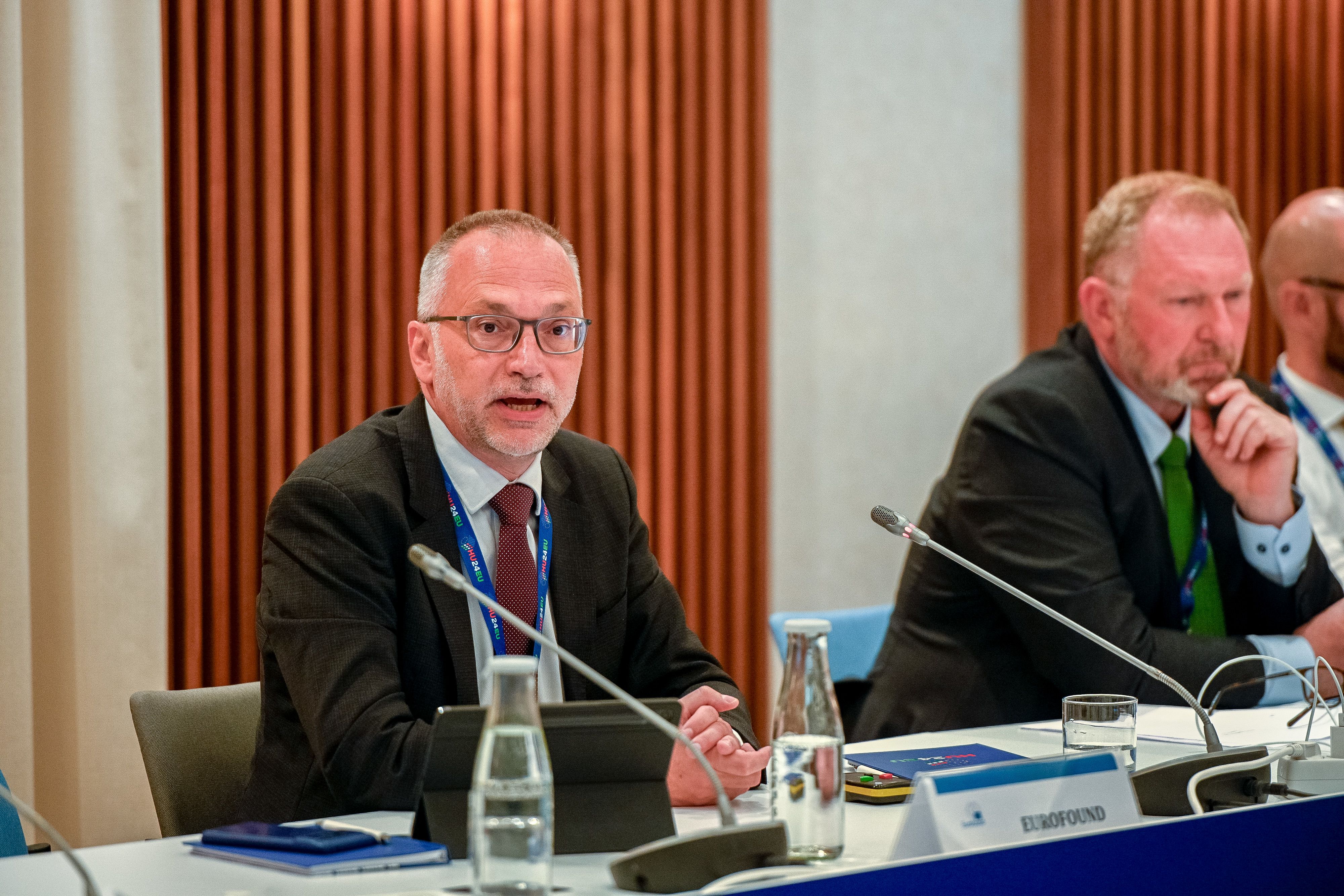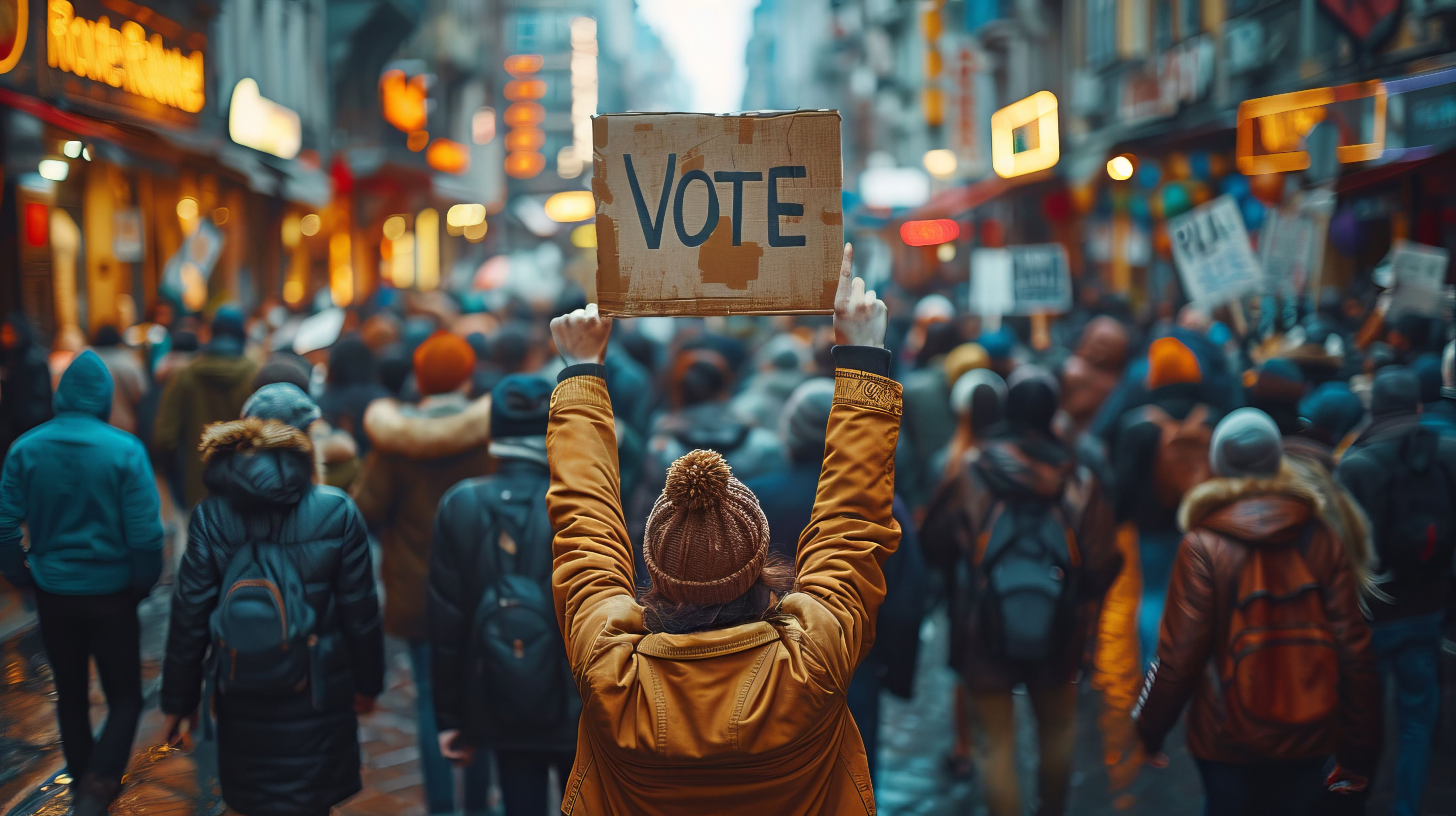Chapter 8:
Trust matters: Cornerstone to democracy and social cohesion
Trust in crisis: A challenge to social cohesion

Key insights
Political social cohesion remains stable. Despite concerns about declining trust, there is no evidence of an overall decline in political social cohesion in Europe over the past 20 years.
Trust in institutions has declined. Trust in the EU has decreased slightly since 2023 but remains higher than pre-pandemic levels. However, trust in national governments remains significantly lower.
Economic hardship erodes trust in institutions. Those struggling to make ends meet report significantly lower levels of trust in both national governments and the EU.
Unemployment weakens political engagement and institutional trust. Unemployed individuals are less likely to vote and to have trust in national governments and the EU, although in some regions this lack of trust drives protest activity.
The rural–urban divide is deepening, fuelling political disengagement and protest. Rural communities report feeling ignored and perceive a lack of political recognition, contributing to growing discontent.
In recent years, the EU has confronted a series of overlapping crises that have collectively strained public trust in both the EU and national institutions. This erosion of trust poses significant risks to social cohesion and democratic stability, as diminished trust can lead to social fragmentation, reduced cooperation and the rise of populist movements.
Without trust, societies fall victim to social fragmentation, which cripples cooperation and can empower populism, thereby undermining the stability and full functioning of our societies during periods of geopolitical tension. Disparities in trust levels extend beyond generational and socioeconomic divides, with growing inequalities between rural and urban areas further exacerbating political discontent.
Rural communities, facing lower employment growth and declining public service provision, increasingly feel overlooked by decision-makers, reinforcing their sense of political exclusion. However, while trust in institutions has come under pressure, this has not necessarily translated into widespread political disengagement. In fact, political participation has remained relatively resilient in many parts of Europe.
'There was no evidence of a decline in political social cohesion.'
'Citizens have consistently participated in the democratic process, including voting, over the past two decades'.

No widespread decline in political social cohesion

Political social cohesion refers to citizens’ engagement and trust in democratic institutions, as well as their participation in political processes, such as voting and civic activism. In 2024, Eurofound looked at trends and regional variations in political participation across Europe, alongside levels of institutional distrust and discontent.
While political disaffection exists in parts of Europe, the data indicate that participation in the democratic process – including voting and protest activity – has remained stable over the past two decades in most regions. Engagement has tended to increase during times of crisis, such as the 2007–2008 financial crisis, the 2010–2012 European debt crisis and the COVID-19 pandemic, suggesting that citizens continue to participate in the democratic process even during challenging periods. During these times, both voting and protest activity rose, particularly in countries where dissatisfaction with government responses was high.
Despite country variations, there has been a convergence between regions with higher and lower levels of political participation in Europe. Regions in southern and eastern Europe, which historically had lower electoral participation rates, are increasingly aligning with those in northern and western Europe, where participation has been stronger. The type of political participation observed includes voting in elections, protesting and petitioning.
Protest participation has risen during periods of crisis, indicating that citizens remain politically engaged even when they disagree with traditional institutions. However, participation alone does not always signal trust. Even as citizens continue to vote or protest, their underlying trust in the institutions they engage with is showing signs of strain.

Declining trust in institutions

In recent years, trust in institutions within the EU has declined due to the rising cost of living and the spread of unreliable news sources (Eurofound, 2022). In the 2024 Living and Working in the EU e-survey, respondents rated their trust in institutions on a scale of 1 to 10. Trust in the EU fell slightly from 5.0 in 2023 to 4.7 in 2024 but remains above pre-pandemic levels (4.5 in 2020) (Figure 28).
Trust in national governments remains significantly lower than trust in the EU, and has seen little change since 2023.
Figure 28: Trust in institutions, EU, 2020–2024 (scale 1–10)
There are notable national differences in trust levels, often influenced by recent elections and political developments. Some countries have seen widening distrust, particularly in parts of central and eastern Europe, where concerns over governance and political shifts have intensified public discontent. In contrast, other Member States, particularly in western and northern Europe, have maintained more stable levels of trust, reflecting consistent institutional performance.
Trust in the healthcare system (5.8) and the police (5.9) remained stable at EU level between 2023 and 2024 but has yet to return to early-pandemic highs (6.2 and 6.4, respectively, in 2020).
Generational differences in trust
Trust is not evenly distributed across the population. Age, in particular, plays a significant role in shaping how citizens perceive institutions.
Among e-survey respondents, young people trust the EU more than older groups, although the decrease in trust was higher among them than among older groups. When it comes to the government and the healthcare system, respondents aged 65 or over had the highest level of trust across the age groups (Figure 29).
Figure 29: Trust in institutions, by age group, EU, 2020–2024 (scale 1–10)
Source: Living and Working in the EU e-survey series

Low levels of trust linked to financial insecurity

Just as age shapes trust, so too does people’s financial situation and their ability to make ends meet. Eurofound research shows that those more affected by the cost-of-living crisis have a much lower level of trust, particularly those who struggle to make ends meet or are behind in their energy bills.
Figure 30 highlights this disparity: trust in government and the EU is notably lower among individuals who report difficulties making ends meet, whereas those who find it easy to make ends meet exhibit significantly higher trust levels. Similarly, individuals with arrears on energy bills report substantially lower levels of trust in government and EU institutions than those without arrears.
Figure 30: Economic hardship and trust in institutions, EU, 2023 (scale 1–10)
Employment is key for democracy
Employment plays a vital role in shaping institutional trust and political engagement. Eurofound’s e-survey findings show that unemployed people are generally less likely to vote and tend to report lower levels of trust in government and the EU. This reinforces a cycle of disengagement and dissatisfaction, where political exclusion and institutional distrust go hand in hand.
However, there are notable differences across Europe. In continental Europe and Ireland, higher unemployment has at times resulted in stronger political participation, including increased voter turnout and protest activity. In contrast, in Nordic, western Mediterranean, and central and eastern European regions, unemployment does not result in stronger political participation.
Similarly, Eurofound research shows that unemployment is important for political engagement through protesting: the higher the unemployment rate, the higher the levels of protest. These differences highlight the complex relationship between employment, protest and trust in institutions.

Rural–urban divide deepens

The growing divide between urban and rural communities is one of the clearest expressions of social and political inequality in the EU. In many rural areas, economic decline and reduced access to public services have fuelled a sense of being left behind – not just economically, but politically and socially.
Low voter turnout in rural areas
The farmers’ protests across Member States, particularly in Brussels in 2024, have placed rural–urban differences in sharp focus, highlighting grievances over economic disparities, regulatory burdens and a perceived lack of representation in policymaking.
These protests have raised broader questions about inequalities in this area, as the EU is witnessing deepening inequalities and a rural–urban gap that has increased by almost 20% in the previous 10 years. The employment rate has increased faster in urban areas than in rural areas, and median incomes are higher in urban areas in almost every Member State. Such inequalities have a hard-hitting impact on social cohesion.
Eurofound findings show that the increasing income gap between rural and urban areas, alongside the employment gap and the relatively poorer provision of public services, has contributed to a rise in feelings of being mistreated, disrespected or ignored by the government. This is more likely to manifest itself in protests, rather than at the ballot box, as discontented citizens are shown to be more likely to engage in protest and less likely to vote.
Lack of recognition and feeling unheard
A crucial component of institutional trust hinges on the belief that citizens’ voices are heard and that their concerns are acknowledged.
However, recent analysis indicates that many people in rural areas, particularly those with lower income levels and limited employment opportunities, feel a lack of political recognition. These communities feel their concerns and grievances are not being adequately addressed by the EU. They feel ignored by policymakers. All of this serves to highlight rural–urban disparities.
This sense of invisibility fosters resentment and can lead to public discontent, including protests and demonstrations. Figure 31 illustrates this divide, showing that individuals who do not feel a lack of recognition by their government report significantly higher trust levels in both national governments and the EU. In contrast, those who feel ignored by their government or believe it cares less about their community exhibit markedly lower trust levels.
Figure 31: Lack of recognition and trust, EU, 2023 (scale 1–10)